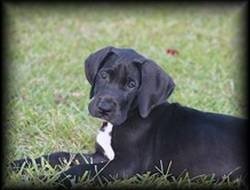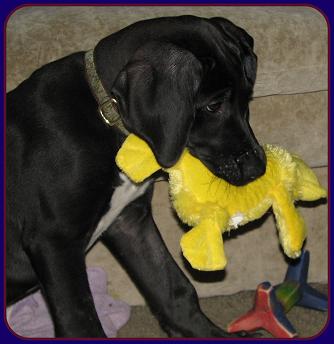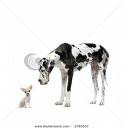
|

|
|
|
| ||
Great Dane HistoryThe Great Dane history may surprise you. The mighty and powerful Great Dane was not always the gentle giant that is portrayed today. In fact, the Great Dane was once a very aggressive fighter and hunter that was terribly feared because of its harsh temperament and combative nature. Great Dane history says the Dane had excellent hunting skills that allowed them to capture and kill wild animals.  The earliest of these dogs were called “Bullenbeissers” and were very similar to the breed we call the Mastiff. The Mastiff, as we know it today, was developed in England, but the Bullenbeisser was definitely of early Germanic origins and was the basic dog from which the many Mastiff-type dogs have derived. From the earliest times, a strain of dogs of the Bullenbeisser type has played a dramatic part in the history of mankind. The ancient Assyrians used these massive, courageous, fierce animals as war and guard dogs, and they were eventually called “molossia” or Molossian dogs after the ancient Grecian city. These huge dogs were know in ancient Egypt and conquering Rome and were in common use among the early Tuetonic and Celtic tribes. Crude drawings and literary references show that through the Middle Ages the large Bullenbeisser was the most commonly used guard dog in Germany, where it was known as the “Deutsche Dogge,” or German dog. Bullenbeissers were also originally hunting dogs, used to chase and bring down mainly wild boars, but also cattle, wolves and elk. Their ears were cropped extremely short to prevent injury as the dog ran through heavy brush and to prevent damage inflicted by the sharp tusks of the boar. As time passed, the wild boar became scarce and “boarhounds,” as they were also called, were not needed anymore. These boars had little resemblance to what we could call an original boar nowadays. These wild animals were fearsome, dangerous, tough and potentially deadly. Hunting these boars required a dog that had courage, speed, and exceptional power. The early Danes fit this model and succeeded admirably at the task. Even though the Great Dane was originally breed for hunting and fighting, other tasks included carting, tracking, and watchdog duties. The breed was also kept as a showpiece for Europes ruling class. The breed was valued for its tremendous build, power, boldness and endurance. It still possesses many of these same qualities today. The ancestors of the Great Dane were most likely of hunting stock. Since the Dane is a taller, trimmer counterpart to the English mastiff, it is probably related to the mastiff in some way. The Dane has even been called the German Mastiff in several countries. There is some controversy over where the Dane originally came from. The Great Dane appears to be largely a German creation, in which Germany takes considerable pride, but some British breed authorities do not agree. It is also true that a very similar dog to the Great Dane was evolving in England and that modern Danes probably do owe some credit to these early British dogs in addition to the German contributions to the Breed. The Great Dane was known as the Boar Hound when it appeared in America late in the 19th century. It is also believed the Great Dane has ancient origins. For example, there is a Grecian coin in the Royal Museum at Munich that dates from the fifth century BC, and it depicts a likeness of a dog that greatly resembles the modern Great Dane. Pictures that closely resemble the Dane have appeared on artifacts of many ancient civilizations, Pre-biblical Assyria, Egypt, ancient Greece and Rome all have artistic evidence of Dane-like dogs. The Great Dane is believed to be a cross of the Mastiff and the Irish Wolfhound. The Great Dane was claimed the national breed of Germany in 1876. Although the AKC classifies the Great Dane as a working breed dog, it is primarily a companion animal. The current world record holder, measuring 43 (109 cm) in from paw to shoulder; 7.2 ft (220 cm) from head to tail, is George. The previous Great Dane to hold the world record as tallest living dog was Gibson, who was 3+1/2 ft (106.7 cm) tall at the withers and 7 ft 1 in (215.9 cm) on his hind legs. The various names used to identify the hound; Great Dane (English speaking world), Gran Danés (Spanish and Portuguese speaking world including South America), Grand Danois (French speaking world, Scandinavia in the 20th Century), Tanskandoggi (Finland), Danubius Dog (Hungary), Danua cinsi kopek or Grand Danua (Tyrkey) and Danische Dogge or Grosse Danische Yagd Hund (German speaking world up until 1888-9) simply reflects the tribal origin of the hounds (see for instance Dr. Leop Jeps Fitzinger: Der Hund und seine Rassen (1876) and Meyers Konversationslexikon. How did a dog once very aggressive and terribly feared, come to be our, now, sweet, gentle, and caring large dogs? Through excellent breeding programs and dedicated fanciers, the breed was transformed over the years into a friendly and loving working dog that is suitable for all families. Great Dane ColorsThere are six show-acceptable coat colors for Great Danes:
Other colors occur occasionally but are not acceptable for conformation showing, and they are not pursued by breeders who intend to breed show dogs. These colors include white, fawnequin, merle, merlequin, fawn mantle, and others. Some breeders may attempt to charge more for puppies of these "rare" colors. However, the breeding of white and merle Danes is particularly controversial, as these colors may be associated with genes that produce deafness. Although they cannot be shown, white or merle Danes can usually still be registered as pedigree dogs. Reference: Wikipedia the Online Encyclopedia Table of Contents | Top Click Here To Visit Kittys Corner  Click Here to Vote for My Site! Click Here to Vote for My Site!
Fun Dog FactsDid you know that the phrase "flea bag" relates to toy breeds of dogs? Dogs have a higher body temperature than humans, and fleas will naturally move to the warmer being. Toy breeds were often used to sit on their masters laps in order to attract fleas and ease their human companion’s discomfort. 
If you find this website useful, please consider helping its production with a donation. Click the Donate button to go to the safe and secure PayPal 
~Kittys Corner~I have a Female Great Dane and her name is Kitty. She will be 2 in July '10. Her mother is a Blue Dane and her dad is a Black Dane. This is a picture of her here and there are lots of pictures of her on this website. This space is called Kittys Corner because when ever I am at my computer working (which is most of the time) Kitty is laying or sitting beside me with her head on my lap. So I made her a corner so she can voice what is going on in her world. ~Enjoy~The weather is so warm and sunny. I was getting tired of the cold and being stuck in the house. Now mom has been back taking me on our walks I missed our walks. Have you been doing anything fun lately? Will you send me your pictures so I can see them? Mom even said something about starting a contest. How fun! So start taking some pictures, or if you already have some, send them in so I can see them. Send in a Picture 
| |
| | ||
Great Dane History Beginning Welcome to the World of the Great Dane.This website strives to bring you the latest information on Great Danes. The content is updated often so make sure and bookmark this site so you can keep up to date on the information. Link To UsReturn to top The Content of this Website is intended as General Information and is NOT Professional Advice. | ||
| | ||



